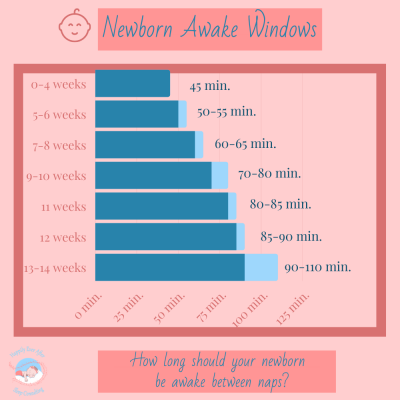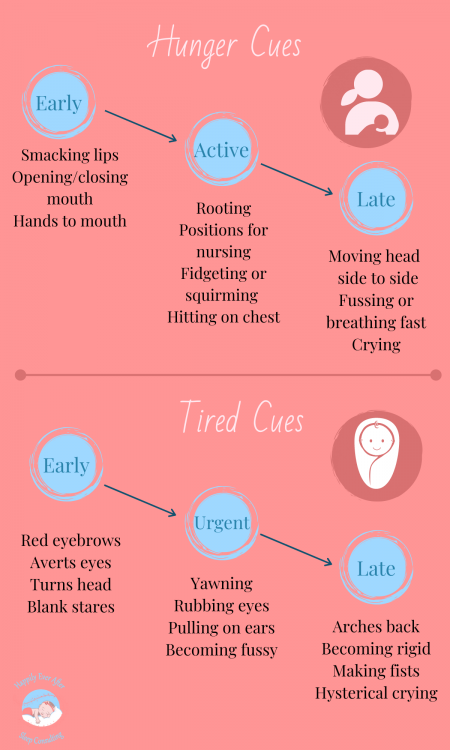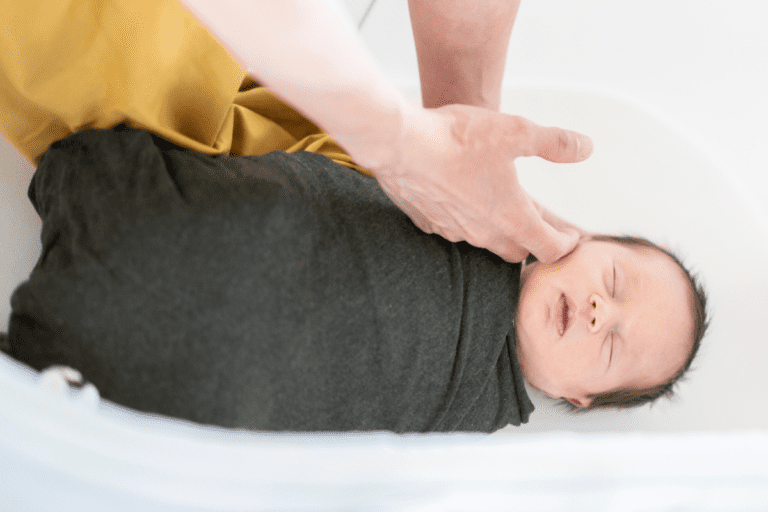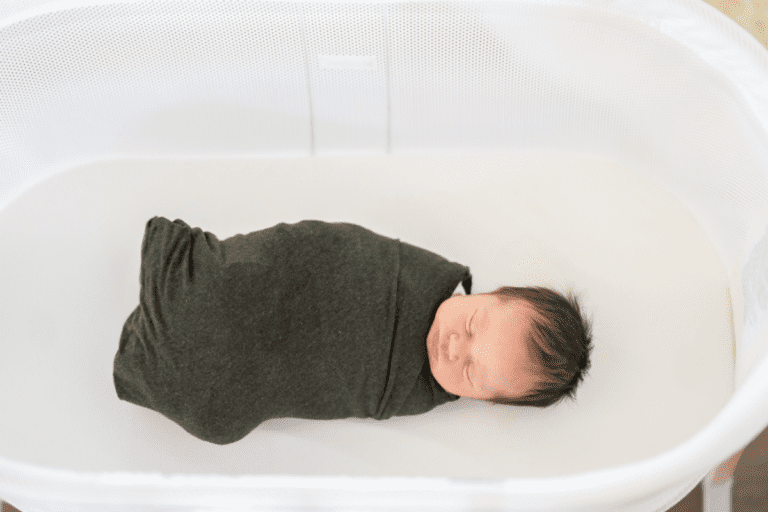Newborn Sleep Tips
If you’re expecting or have a newborn at home, congratulations! Prepare for a whirlwind of emotions, which no book or blog or advice can prepare you for. You may have read some parenting books, researched breast feeding, but sleep? Most parents don’t think about baby sleep until they’re sleep deprived.
Now I’m not suggesting that you sleep train your newborn, but I am going to share some newborn sleep tips that you can implement early on to avoid sleep training down the road. These are the foundations of what I work on with my Newborn mom clients.
Newborn Sleep Tip 1: Awake Windows

The first thing is timing. Now, newborn babies, and this may be a surprise to you, but newborn babies can really only tolerate about 45 minutes of time awake before they need to sleep again. I’m talking babies under 6 weeks old. Around the 7-8 week mark your baby can start handling 60 minutes awake. Screen shot that awake window chart!
That is not a lot of time if you consider a feed takes 20 to 30 minutes, then a diaper change, maybe a little bit of playtime, and now it’s time to go back to bed. If you are waiting for those sleepy cues, when baby gets fussy, it’s going to be much harder to get your baby to sleep. And then you wonder why your baby is fighting sleep. That, momma, is overtiredness at it’s finest.
A fussy, cranky baby often looks like a hungry baby. And a lot of people misread the signs. And what ends up happening is we end up feeding our baby for both hunger-related issues and feeding our baby around fatigue-related issues. That takes me to my next tip!

Newborn Sleep Tip 2: Attempt a Nap Before a Feed
Hunger cues and sleep cues can look similar. You want to screen shot that chart! So, if your little one is getting cranky and you fed them recently, look at the clock. If it’s been 45-60 minutes try putting them down for nap versus offering another feed. Try getting them down before it’s too late to prevent overtiredness.
I don’t want to stop you from feeding your baby, but I can remember how many times I would feed my youngest instead of trying for sleep. Then she would end up spitting up and being even crankier! Feeding on demand is not feeding your baby every time they cry, so knowing whether it’s a hunger or tired cry is important.

Newborn Sleep Tip 3: Put Baby Down Before She’s Asleep
Are you ready for this one? Try to put your baby down for sleep before he or she is asleep! *gasp* Believe it or not you don’t always have to soothe your baby to sleep. If you would’ve told me this when my girls were babies I would’ve thought you were crazy!
I definitely didn’t practice this, but it’s because I didn’t know any different! I would be stuck for most naps which I loved the snuggles, but it would’ve been nice to get them sleeping independently once in a while!
As I mentioned before, you can’t sleep train a newborn but you can help them start to learn how to self soothe and fall asleep on their own. Make sure to follow your child’s awake windows and put them down drowsy, but before they are completely asleep.
Sometimes they may just drift off on their own and that is an amazing thing because that means baby is figuring out how to do this on their own, and isn’t always going to require you to help her fall asleep. That is moving baby down the right path for independent sleeping.
Other times baby won’t fall asleep and they will need your help and that’s okay! You just want to give them a chance to fall asleep without always being fed or rocked to sleep. Even if you just try this for the first nap of the day, that’s a great start!

Newborn Sleep Tip 4: Exposure to Daylight
Babies are born with an immature circadian rhythm so their sleep is unpredictable. They only have 2 sleep cycles- REM and NON-REM or deep sleep.
You want help your newborn differentiate day from night. Frequent daytime feeds (every 2-3 hours) and daylight exposure will help regulate their body clock. Exposure to light first thing in the morning helps sets their wake-up time.
You don’t have to be outside, simply opening up the blinds and letting in the sunlight. Lots of exposure to daylight during the day also aids nighttime sleep.
Make morning no earlier than 6 am, bring your baby out into a common room with lots of sunlight for the first feed of the day. You want to aim for 12 hours of day and 12 hours of night, so if your baby’s bedtime is 9 pm, then you want to aim for morning to be 9 am.
Napping your baby in a bright room is okay for their first few weeks, but you’ll want to read my next tip to hear more about the benefits of DARKNESS.
As your baby gets older she will be able to sleep longer stretches at a time, your goal is to make sure this longer stretch happens at night.
Newborn Sleep Tip 5: Dark Room
You may have heard this before. Make sure baby’s room is DARK for sleep especially naps! Daylight can interfere with baby falling asleep. But I just talked about the importance of daylight? Confusing right? Stick with me.
Daylight helps set your baby’s body clock, but too much daylight can be overstimulating. Because your little one can only handle 45-60 minutes awake, they need that naptime to shut down and avoid that overstimulation. Baby’s sleep best in a dark room. You can start this around the 4-6 week mark for all naps.
Room darkening curtains can help make baby’s room dark along with window covers like the Blackout EZ Window Cover. When you’re traveling there are lots of options, like the gro anywhere blind (Amazon Basics Travel Blackout Blinds is the cheaper version) which has suction cups that make it easy to put on windows. You can also use a black trash bag or foil taped to the windows as an inexpensive solution!
When it comes to your little one’s room, less is better. I have a free resource on my best tips to make your little one’s room a sleep sanctuary.
5 S's
All of the tips I have shared so far can help baby sleep longer or prevent overtiredness. But what can you do if your baby is fussy and won’t calm down?
Have you heard of the 5 S’s? Dr. Harvey Karp came up with these methods when he figured out that newborn babies need sensations like they had in the womb. These calming sensations keep babies relaxed.
So what are these 5 S’s?
Swaddle
💤 Swaddling your baby recreates the snug feeling of being inside the womb. Make sure their arms are wrapped snug at their side, with their hips loose. I recommend not swaddling babies past 10-12 weeks.
Side or Stomach
💤 Holding a baby on her side or stomach can help calm her.
Shush
💤 White noise mimics the loud, calming sounds from the womb.
Swing
💤 Slow rocking is good to get a calm baby to sleep. For a fussy, crying baby, use fast and tiny motions like when they were in the womb.
Suck
💤 Many babies have a strong need to suck (often why they fall asleep while breastfeeding or bottle feeding). A pacifier can calm a baby quickly.
All the information on these 5 S’s can be found here.
Safe Sleep
I can’t write a Newborn Blog Post without talking about safe sleep! It’s one of the most important things to practice with a newborn! There are several recommendations from the AAP for safe sleep to reduce the risk of SIDS (Sudden Infant Death Syndrome).
💤 Back to sleep for every sleep
💤 Firm sleep surface
💤 Room sharing without bed sharing
💤 Keep soft objects and loose bedding away from infant’s sleep area
💤 Offering a pacifier
💤 Avoid alcohol and illicit drug use during pregnancy and after birth
💤 Avoid overheating and head covering in infants
💤 Avoid use of commercial devices that are unsafe
All of the above information can be found at www.aap.org
If you want some support with your newborn or you’re expecting and want to be prepared to start your little one’s sleep journey off right, I would love to be your sleep guide! Book a sleep solution call with me today!


2 thoughts on “Newborn Sleep Tips”
Pingback: How to Prepare for Baby Coming Home - Happily Ever After Sleep
Pingback: Sleep Strategies for Multiples - Happily Ever After Sleep
Comments are closed.